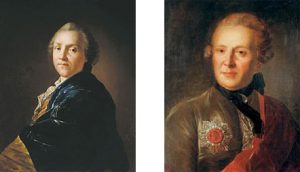Portraits of Sumarokov by A. Losenko and F. Rokotov
 When the painter paints a portrait of a contemporary, he sees it as if in the “halo” of events, the ideological aspirations of his era, perceives him as a person with thoughts that are well understood by him. Apparently, it was not by chance that famous painters captured for the descendants of the famous poet and playwright A. P. Sumarokov.
When the painter paints a portrait of a contemporary, he sees it as if in the “halo” of events, the ideological aspirations of his era, perceives him as a person with thoughts that are well understood by him. Apparently, it was not by chance that famous painters captured for the descendants of the famous poet and playwright A. P. Sumarokov.
Of course, these masters of the XVIII century worked as part of the portrait canon, which prescribed a certain measure of idealization of the model. And yet they were able to perceive the portrayed deeply, with interest. Sumarokov turned out to be at the crossroads of two artistic “opinions” – in many respects not similar, separated by a considerable period of time. This is a precious opportunity for today’s viewer: the historical face is turned, as it were, by various sides, facets of character. And now his life passes before us …
He was a bright, complex, controversial person. Alexander Petrovich Sumarokov – the founder of Russian classical drama, organizer and director of the Russian professional theater created in 1756, publisher of the magazine “Hardworking Bee”. He was born in 1717, came from a family of noble but impoverished nobles. A thirteen-year-old boy was sent to the cadet corps, which was then called the “knight academy.” At the same time, future talented diplomats, political figures, translators, poets, and generals were trained: Repnin, Panin, Svistunov, Kheraskov, Elagin, Kamensky, Rumyantsev-Zadunaisky.
Many of Sumarokov’s classmates try themselves in versification, but he is the brightest of all in this field. His poems inherent scope, pathetics:
Peter uses nature
New souls in us;
He builds an army, enters Pont.
And in the days of such change
Burns fire, destroys walls
Rips and moves the horizon …
The young poet is hardworking, because he is one of the pioneers in Russian poetry: “It was as if I passed through the dense forest concealing the dwelling of the muses from my eyes, without a guide.” The difficulties of the first experiments in the genre of exquisite literature brighten the success of the readers, and after the first play entitled “The Chorev” is staged – also among the audience. The range of interests of Sumarokov is strikingly wide. He writes works on history, philosophy, philology. Passionately in love with his brainchild – the first professional theater, whose repertoire included Sumarok plays. Their main theme is the glorification of civic duty and virtues, the mockery of vices. In total, he wrote more than 20 dramatic works. The performances were richly decorated, accompanied by music, attracted a brilliant game of the best actors of the time: F. G. Volkov, I. A. Dmitrievsky, Ya. D. Shuisky. The novelty of the spectacle was admired by the audience, but soon the content of the plays, where Sumarokov risked lecturing the empress, caused irritation at the court, and he was dismissed from the post of director. At the same time the publishing activity of the poet ended. This was reflected in his state of mind, which was already overshadowed by the endless intrigues of the envious. In a difficult period for the poet’s life, in 1760, his portrait was painted by A. Losenko.
For this historical painter, the theme of civil striving became one of the most important in art. And this portrait is evidence of this. The master depicted Sumarokov in a sharp turn. The head is proudly thrown up, the figure is wrapped up in a raincoat. He seems to be a classic tragedy hero, resisting the blows of fate. The pose is a little theatrical, the cloak defiantly drapes the figure, but how much hidden human suffering reflects the face! Sumarokov is pale: a straight, penetrating gaze is directed straight at the viewer, a bitter fold lies in the corner of his mouth. The color of the canvas was decidedly discreetly, even strictly – almost a black background, a stain of a dark blue raincoat, and an ocher face with pink shades. A corner of white lace jabot is written in a reverent way, the only light accent in the ascetic range of the portrait. This is drama of color, a symbol of timid hope for a prosperous future. Losenko executed the portrait of the playwright immediately after the ban on the magazine “The Hardworking Bee”, another Sumarokov’s brainchild. The last issue of the Sumarokov edition ended with bitter lines:
Parnassus descend, I go against the will
In time to heighten my heat
And I will not go up to death anymore –
My fate then share
Goodbye muses forever!
I will never write more.
Losenko tells about the fate of the poet, which is revealed as the drama of the persecuted creator.
When the portrait of Sumarokov entered the museum, he immediately attracted attention with color. Scenic handwriting did not leave doubts about the authorship of Rokotov. The combination of colors: olive-green – in a caftan, black – in a neckerchief, scarlet – in the Annna tape, running down the left shoulder, dark brown in a raincoat – a characteristic range of Rokotov’s painting. And all of it is brought to unity by a silvery tonality.



